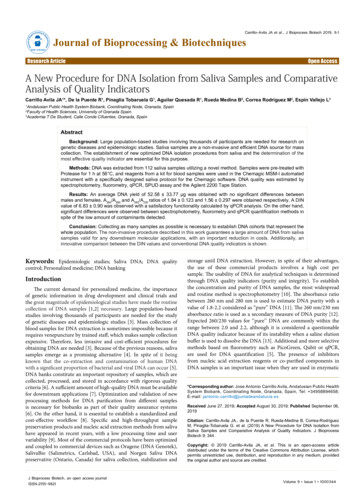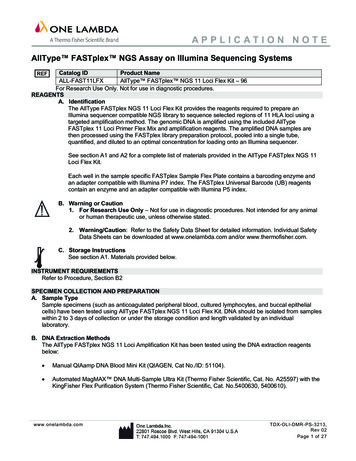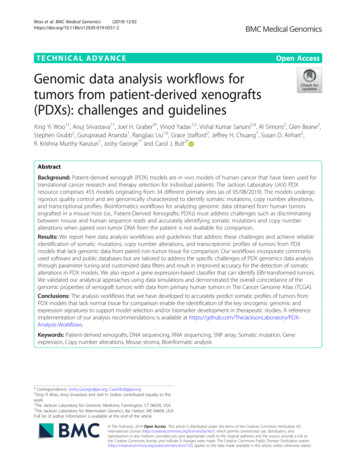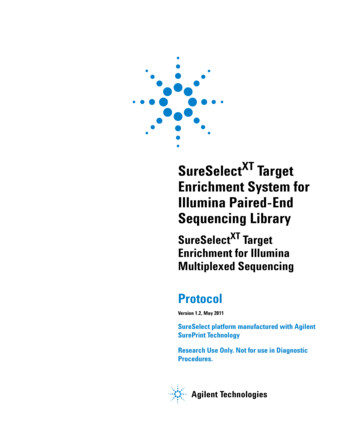
Transcription
USER GUIDEQubit Protein Assay KitsCatalog Numbers Q33211, Q33212Pub. No. MAN0002349 Rev. B.0WARNING! Read the Safety Data Sheets (SDSs) and follow the handling instructions. Wear appropriate protective eyewear,clothing, and gloves. Safety Data Sheets (SDSs) are available from thermofisher.com/support.Product description The Qubit Protein Assay Kits make protein quantitation easy and accurate. The kits include concentrated assay reagent, dilution buffer,and prediluted BSA standards. Simply dilute the reagent using the buffer provided, add your sample (any volume from 1–20 µL is acceptable), then read the concentration using the Qubit Fluorometer. The assay is accurate for initial sample concentrations from12.5 µg/mL to 5 mg/mL and exhibits low protein-to-protein variation (Figure 1). The assay is performed at room temperature, and thesignal is stable for 3 hours. Common contaminants such as reducing reagents (DTT, β-mercaptoethanol), salts, free nucleotides, aminoacids, solvents, or DNA (but not detergents) are well tolerated in the assay; some very slight modifications for the procedure are required for other contaminants (see “Contaminants tolerated by the Qubit protein assay” on page 4). In addition to the Qubit Protein AssayKits described here, we also offer other kits for assaying dsDNA and RNA (see “Related products” on page 7). Note: This Qubit assay kit can be used with any Qubit Fluorometer.Figure 1 Low protein-to-protein variation in the Qubit protein assay. Solutions of the following proteins were prepared, diluted, and assayed in the Qubit protein assay: bovine serum albumin (BSA), chicken-eggovalbumin, chicken-egg lysozyme, bovine-milk β-casein, equine myoglobin, bovine-milk α-casein, porcine pepsin, mouse immunoglobulin (IgG),and calf thymus histone. Fluorescence was measured at 485/590 nm and plotted versus the mass of the protein sample. At 3 μg, the fluorescencevariation was 12.4%, or 8.7% excluding the basic histone protein. Background fluorescence has not been subtracted.For Research Use Only. Not for use in diagnostic procedures.
Contents and storage For use with the Qubit Fluorometer (all models)ComponentCat. No. Q33211Cat. No. Q33212(100 assays)(500 assays)300 µL1.5 mLQubit Protein Reagent(Component A)ConcentrationStorage[1]200X concentrate in1,2‑propanediolRoom temperatureDesiccateProtect from lightQubit Protein Buffer(Component B)60 mL300 mLNot applicableRoom temperatureQubit Protein Standard #1(Component C)1 mL5 mL0 ng/µL in TE buffer with2 mM sodium azide 4 Qubit Protein Standard #2(Component D)1 mL5 mL200 ng/µL in TE buffer with2 mM sodium azideQubit Protein Standard #3(Component E)1 mL5 mL400 ng/µL in TE buffer with2 mM sodium azide [1]When stored as directed, kits are stable for 6 months.Materials required not supplied Plastic container (disposable) for mixing the Qubit working solution (step 3 on page 5) Qubit Assay Tubes (500 tubes, Cat. No. Q32856) or Qubit Flex Assay Tube Strips (Cat. No. Q33252)Guidelines for handling the Qubit Protein Reagent No data are currently available that address the mutagenicity or toxicity of the Qubit Protein Reagent (Component A). This reagent is an organic dye and is provided as a solution in 1,2‑propanediol. Treat the Qubit Protein Reagent with the same safety precautions as othermaterials with similar properties and dispose of the dye in accordance with local regulations.Critical assay parametersAssay temperature The Qubit protein assay delivers optimal performance when all solutions are at room temperature. The Qubit assays are designed to beperformed at room temperature, as temperature fluctuations can influence the accuracy of the assay (Figure 2). To minimize temperature fluctuations, store the Qubit protein reagent and buffer at room temperature and insert all assay tubes into the Qubit Fluorometer only for as much time as it takes for the instrument to measure the fluorescence; the Qubit Fluorometer can raise the temperature of theassay solution significantly, even over a period of a few minutes. Do not hold the assay tubes in your hand before reading because thiswarms the solution and results in a low reading.Figure 2 Plot of fluorescence vs. temperature for the Qubit protein assay.The Qubit assays are designed to be performed at room temperature, as temperature fluctuations can influence the accuracy of the assay.2 Qubit Protein Assay Kits User Guide
Incubation time To allow the Qubit protein assay to reach optimal fluorescence, incubate the tubes for 15 minutes after mixing the sample or standardwith the working solution. After this incubation period, the fluorescence signal is stable for 3 hours at room temperature. For the greatest accuracy of the Qubit protein assay, the incubation time of the samples should be within 10 minutes of the incubation time of thestandards.Photostability of the Qubit reagents The Qubit reagents exhibit high photostability in the Qubit Fluorometer, showing 0.3% drop in fluorescence after 9 readings and 2.5% drop in fluorescence after 40 readings. However, if the assay tube remains in the Qubit Fluorometer for multiple readings, atemporary reduction in fluorescence will be observed as the solution increases in temperature (Figure 2). Note that the temperature inside the Qubit Fluorometer may be as much as 3 above room temperature after 1 hour. For this reason, if you want to perform multiplereadings of a single tube, remove the tube from the instrument and let it equilibrate to room temperature for 30 seconds before takinganother reading.Calibrate the Qubit FluorometerFor each assay, you have the choice to run a new calibration or to use the values from the previous calibration. When you first use theinstrument, perform a new calibration each time. As you become familiar with the assays, the instrument, your pipetting accuracy, andsignificant temperature fluctuations within your laboratory, you can decide the level of comfort you have using the calibration data storedfrom the last time the instrument was calibrated. Remember that the fluorescence signal in the tubes containing standards and samples isstable for no longer than 3 hours. See Figure 3 for an example of the calibration curve used to generate the quantification results.Figure 3 The curve-fitting algorithm used to determine concentration in the Qubit protein assay.The Qubit Fluorometer generates concentration data based on the relationship between the three standards used in the calibration. This plot shows the line corresponding to the curve-fitting algorithm (a modified Hill plot) used in the calculation of concentration data for the Qubit proteinassay. For reference, the positions of the standards and a set of data points from an actual experiment are shown superimposed onto the line,demonstrating that the curve-fitting algorithm gives accurate values for quantitation. Qubit Protein Assay Kits User Guide3
Contaminants tolerated by the Qubit protein assayTable 1 Effect of contaminants in the Qubit protein assay, tested over a range of 1.25–25 µg/mL*Final concentration in theassayConcentration in 20‑µLsampleConcentration in 10‑µLsampleResultSodium chloride20 mM200 mM400 mMOK [1]Magnesium chloride2 mM20 mM40 mMOKPotassium chloride [2]200 mM200 mM400 mMOKCalcium chloride[2]2 mM20 mM40 mMOKAmmonium sulfate5 mM50 mM100 mMOK[1]DTT1 mM10 mM20 mMOK[1]β-Mercaptoethanol1 mM10 mM20 mMOKEDTA1 mM10 mM20 mMOKSodium azide1 mM10 mM20 mMOKHEPES, pH 7.45 mM50 mM100 mMOKPotassium phosphate, pH7.45 mM50 mM100 mMOKContaminantPBS, pH 7.41 mM KPO4 15 mM NaCl10 mM KPO4 150 mM NaCl 20 mM KPO4 300 mM NaClProtocol modificationrequired [3]Sucrose50 mM500 mM1MOKSucrose100 mM1M2MNRGlycerol1%10%20%OK[1]Imidazole1.25 mM12.5 mM25 mMOKSDS0.01%0.1%0.2%OK[1]SDS0.02%0.2%0.4%NRTween 200.001%0.01%0.02%NRTriton X-1000.001%0.01%0.02%NRAmino acids [4] 100 µg/mL1 mg/mL2 mg/mLOKdNTPs[5]100 µM1 mM2 mMOK[1]DNA5 µg/mL50 µg/mL100 µg/mLOK[1]DNA10% [6]10%[6]10%[6]OKDNA50%[6]50%[6]50%[6]NR*BSA standards were assayed in the presence or absence of contaminants at the indicated final concentrations. Equivalent concentrations(approximate) in 20‑µL or 10‑µL sample volumes are also listed. Results are given as OK, usually less than 10% perturbation, or as NR (notrecommended).[1][2][3][4][5][6]An acceptable result, but with some distortion of the standard curve. For best results, add the same amount of contaminant to the standard samples.A precipitate was observed.For accurate results, add the same amount of PBS to the standard samples.A mixture of 19 amino acids.A mixture of dATP, dCTP, dGTP, and dTTP.For each data point, the DNA mass was a fixed percentage of the protein mass.Prepare samples and standards This protocol assumes that you are preparing standards for calibrating the Qubit Fluorometer. If you plan to use the last calibrationperformed on the instrument (see “Calibrate the Qubit Fluorometer” on page 3), you need fewer tubes (step 1) and less working solution(step 3).4 Qubit Protein Assay Kits User Guide
1. Set up the required number of 0.5‑mL tubes for standards and samples. The Qubit protein assay requires 3 standards. Note: Use only thin-wall, clear, 0.5-mL PCR tubes (Cat. No. Q32856) for the Qubit 4 Fluorometer and 8 200-μL tube strips (Cat. No. Q33252) for the Qubit Flex Fluorometer.2. Label the tube lids.Note: Do not label the side of the tube as this could interfere with the sample read. Label the lid of each standard tube correctly. Calibration of the Qubit Fluorometer requires the standards to be inserted into the instrument in the right order. 3. Prepare the Qubit working solution by diluting the Qubit Protein Reagent 1:200 in Qubit Protein Buffer. Use a clean plastic tube each time you prepare Qubit working solution.IMPORTANT! Do not mix the working solution in a glass container. Note: The final volume in each tube must be 200 µL. Each standard tube requires 190 µL of Qubit working solution, and each sample tube requires anywhere from 180–199 µL. Prepare sufficient Qubit working solution to accommodate all standards andsamples.For example, for 7 samples, prepare enough working solution for the samples and 3 standards: 200 µL per tube in 10 tubes yields 2 mL of working solution (10 µL of Qubit reagent plus 1990 µL of Qubit buffer). 4. Add 190 µL of Qubit working solution to each of the tubes used for standards. 5. Add 10 µL of each Qubit standard to the appropriate tube, then mix by vortexing 2–3 seconds. Be careful not to create bubbles. Note: Careful pipetting is critical to ensure that exactly 10 µL of each Qubit standard is added to 190 µL of Qubit working solution. 6. Add Qubit working solution to individual assay tubes so that the final volume in each tube after adding sample is 200 µL. Note: Your sample can be anywhere from 1–20 µL. Add a corresponding volume of Qubit working solution to each assay tube:anywhere from 180–199 µL. 7. Add each sample to the assay tubes containing the correct volume of Qubit working solution, then mix by vortexing 2–3 seconds.The final volume in each tube should be 200 µL.8. Allow all tubes to incubate at room temperature for 15 minutes, then proceed to read standards and samples (next section).Read standards and samplesFollow the procedure appropriate for your instrument.Read samples and standards with the Qubit 4 Fluorometer For a more complete overview on using the Qubit 4 Fluorometer, please refer to Qubit 4 Fluorometer User Guide (Pub. No.MAN0017209), available for download at thermofisher.com/qubit. 1. On the home screen of the Qubit 4 Fluorometer, press Protein then select Protein. Press Read standards to proceed.Note: If you have already performed a calibration for the selected assay, the instrument prompts you to choose between readingnew standards and running samples using the previous calibration. If you want to use the previous calibration, skip to step 5 below.2. Insert the tube containing Standard 1 into the sample chamber, close the lid, then press Read standard. When the reading iscomplete ( 3 seconds), remove Standard 1.3. Insert the tube containing Standard 2 into the sample chamber, close the lid, then press Read standard. When the reading iscomplete, remove Standard 2.4. Insert the tube containing Standard 3 into the sample chamber, close the lid, then press Read standard. When the reading iscomplete, remove Standard 3.5. Press Run samples.6. On the assay screen, select sample volume and units. Press the or – buttons on the wheel to select sample volume added to theassay tube (1 μL 20 μL).7. From the drop-down menu, select the units (μg/mL, mg/mL) for the output sample concentration. Qubit Protein Assay Kits User Guide5
8. Insert sample, close lid, then press Read Tube. When the reading is complete ( 3 seconds), remove the sample tube. Theinstrument displays the results on the assay screen. The value displayed is the concentration of the sample.9. Repeat step 7 until all samples have been read.Read samples and standards with the Qubit Flex Fluorometer For a more complete overview on using the Qubit Flex Fluorometer, please refer to Qubit Flex Fluorometer User Guide (Pub. No.MAN0018186), available for download at thermofisher.com/qubit. 1. On the home screen of the Qubit Flex, select Protein. Press Read standards and run samples to proceed.Note: If you have already performed a calibration for the selected assay, the instrument prompts you to choose between readingnew standards and running samples using the previous calibration. If you want to use the previous calibration, skip to step 5 below.2. Insert the tubes containing Standard 1 into the sample chamber, close the lid, then press Read standard. When the reading iscomplete ( 3 seconds), remove Standard 1.3. Insert the tubes containing Standard 2 into the sample chamber, close the lid, then press Read standard. When the reading iscomplete, remove Standard 2.4. Insert the tubes containing Standard 3 into the sample chamber, close the lid, then press Read standard. When the reading iscomplete, remove Standard 3.5. Press Run samples.6. On the assay screen, select Output sample units from the drop-down menu. Press to deselect tube positions that do not contain asample. Select Next.7. Press the or – buttons on the wheel to select sample volume added to the assay tube (1 μL 20 μL).8. Insert sample, close lid, then press Read Samples. When the reading is complete ( 3 seconds), remove the sample tubes. Theinstrument displays the results on the assay screen. The value displayed is the concentration of the sample.9. For additional samples select Add samples.10. Insert tubes and deselect tube positions that do not contain a sample. Select Run samples.11. Repeat step 9 and step 10 until all samples have been read.6 Qubit Protein Assay Kits User Guide
Related productsTable 2 AssaysProductQuantitation rangeQubit Protein BR Assay Kit[1]0.1–20 mgQubit Protein Assay Kit12.5–5,000 μgQubit 1X dsDNA HS Assay Kit0.1–120 ngQubit 1X dsDNA BR Assay Kit 4–4,000 ngQubit dsDNA HS Assay Kit 0.1–120 ngQubit dsDNA BR Assay Kit4–2,000 ngQubit ssDNA Assay Kit0.2–240 ngQubit RNA IQ Assay KitN/AQubit RNA HS Assay Kit4–200 ngQubit RNA BR Assay Kit 10–1,200 ngQubit RNA XR Assay Kit 100–20,000 ngQubit microRNA Assay Kit0.5–150 ngQubit 4 System Verification AssayKitN/AQubit Flex System VerificationAssay KitN/A[1]QuantityCat. No.100 reactionsA50668500 reactionsA50669100 reactionsQ33211500 reactionsQ33212100 reactionsQ33230500 reactionsQ33231100 reactionsQ33265500 reactionsQ33266100 reactionsQ32851500 reactionsQ32854100 reactionsQ32850500 reactionsQ32853100 reactionsQ1021275 reactionsQ33221275 reactionsQ33222100 reactionsQ32852500 reactionsQ32855100 reactionsQ10210500 reactionsQ10211100 reactionsQ33223500 reactionsQ33224100 reactionsQ32880500 reactionsQ3288150 reactionsQ3323750 reactionsQ33254Qubit Protein BR Assay Kit is designed for use with Qubit 4 only.Table 3 InstrumentsProductCat. No.Qubit Flex FluorometerQ33327Qubit Flex Fluorometer NGS Starter KitQ45893Qubit Flex Fluorometer Quantitation Starter KitQ45894Qubit 4 FluorometerQ33238Qubit 4 NGS Starter KitQ33240Qubit 4 Quantitation Starter KitQ33239Qubit 4 RNA IQ Starter KitQ33241Qubit 4 Protein BR Starter KitA51292 Qubit Protein Assay Kits User Guide7
Table 4 Consumables/AccessoriesProductQuantityCat. No.125 tube stripsQ33252500 tubesQ32856Qubit 4 Fluorometer International Power Supply(replacement)1 eachA36204Qubit 4 USB Flash Drive1 eachQ46009Qubit Flex Assay Tube Strips Qubit Assay Tubes Limited product warrantyLife Technologies Corporation and/or its affiliate(s) warrant their products as set forth in the Life Technologies' General Terms andConditions of Sale at onditions.html. If you have any questions, pleasecontact Life Technologies at www.thermofisher.com/support.Life Technologies Corporation 29851 Willow Creek Eugene, Oregon 97402 USAFor descriptions of symbols on product labels or product documents, go to thermofisher.com/symbols-definition.The information in this guide is subject to change without notice.DISCLAIMER: TO THE EXTENT ALLOWED BY LAW, THERMO FISHER SCIENTIFIC INC. AND/OR ITS AFFILIATE(S) WILL NOT BE LIABLE FOR SPECIAL, INCIDENTAL, INDIRECT,PUNITIVE, MULTIPLE, OR CONSEQUENTIAL DAMAGES IN CONNECTION WITH OR ARISING FROM THIS DOCUMENT, INCLUDING YOUR USE OF IT.Revision history: Pub. No. MAN0002349RevisionDateB.0A.0February 8, 2022February 2015DescriptionUpdated format and contentNew manualImportant Licensing Information: These products may be covered by one or more Limited Use Label Licenses. By use of these products, you accept the terms and conditions of allapplicable Limited Use Label Licenses. 2022 Thermo Fisher Scientific Inc. All rights reserved. Triton is a trademark of The Dow Chemical Company. Tween is a trademark of CRODA AMERICAS LLC. All trademarks are theproperty of Thermo Fisher Scientific and its subsidiaries unless otherwise specified.thermofisher.com/support thermofisher.com/askaquestionthermofisher.com8 February 2022
for other contaminants (see "Contaminants tolerated by the Qubit protein assay" on page 4). In addition to the Qubit Protein Assay Kits described here, we also offer other kits for assaying dsDNA and RNA (see "Related products" on page 7). Note: This Qubit assay kit can be used with any Qubit Fluorometer.










